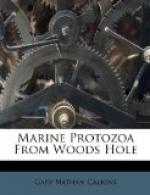Astasia contorta Duj. Fig. 16.
Astasia inflata Duj. ’41.
The body is colorless, transparent, and flexible. It is largest in the center, thence tapering at the two extremities. The surface of the cuticle is obliquely striated, giving to the animal a distinctly twisted appearance. The contractile vacuole is in the anterior neck-like portion of the body. The flagellum is inserted in a distinct oesophageal tube, into which the contractile vacuole empties. This tube is continued into a deeper pharyngeal apparatus of unknown function.
Common in decaying algae. Length 60 mu; greatest diameter 30 mu.
[Illustration: Fig. 16.—Two aspects of Astasia contorta.]
Genus ANISONEMA Buetschli
Flagellates with two flagella, of which one is directed forwards and is concerned with the locomotion of the animal, while the other is directed backwards and drags after the animal when in motion. Body slightly compressed dorso-ventrally (fig. 17, section). An oral furrow is present on the ventral side and the two flagella originate in it (fig. 17, at left). The vacuole is on the left side. Food vacuoles are present in the posterior part. The nucleus is central. Movement creeping.
Fresh and salt water.
Anisonema vitrea (Duj.) Fig. 17.
Synonyms: Tropidoscyphus octocostatus Stein ’83; Sphenomonas Kent ’81; Ploeotia vitrea Senn 1900.
With the characteristics of the genus. It differs from freshwater forms in having eight furrowed surfaces running somewhat spirally from the posterior to the oral end. Length 50 mu; width 23 mu. This attractive flagellate was quite common in decaying algae at Woods Hole; its shaking movement, its peculiar furrowed surfaces, and, above all, its perfectly transparent, vitreous appearance, were well described by Dujardin. Stein’s Tropidoscyphus octocostatus is a fresh-water form which may possibly be a distinct species, especially as it is described with both flagella directed forwards.
[Illustration: Fig. 17.—Anisonema vitrea.]
Genus DISTEPHANUS Stoehr.
An aberrant flagellate bearing a single flagellum and a silicious skeleton resembling those of the Radiolaria. The skeleton consists of two rings of different diameter parallel with one another and connected by silicious bars. From the wider ring half a dozen bars radiate outwards and a similar number of short thorn-like bars point inwards obliquely. The color is yellow, and except for the flagellum the form might easily be mistaken for a Radiolarian, as has been the case repeatedly.
Distephanus speculum Stoehr.
Dictyocha speculum Stoehr; Dictyocha Auc.
With the characters of the genus.
A single specimen only of this very interesting form was seen at Woods Hole. It occurred in a collection of tow made near the end of the wharf during the evening.




